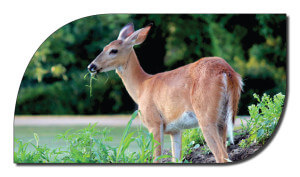“Annual estimates of deer damage are reported to exceed $2 billion nationwide, including… more than $250 million in damage to metropolitan households.”
Did you know that a hungry deer can reach 7 feet high? If these animals are damaging your trees, you’re not alone. These seemingly innocent creatures are infamous for scraping trees with their antlers and eating the foliage and fruit.
You probably have questions like: How do I keep deer from eating my trees? What can I spray on my trees to keep deer away? Do coffee grounds keep deer away? Does burlap protect trees from deer?
It’s a huge bummer to see tree damage. If you’re wondering how to keep deer away and out of your yard or garden, you can learn how to protect trees from deer with this complete guide.
HOW DO DEER DAMAGE YOUR LANDSCAPE?
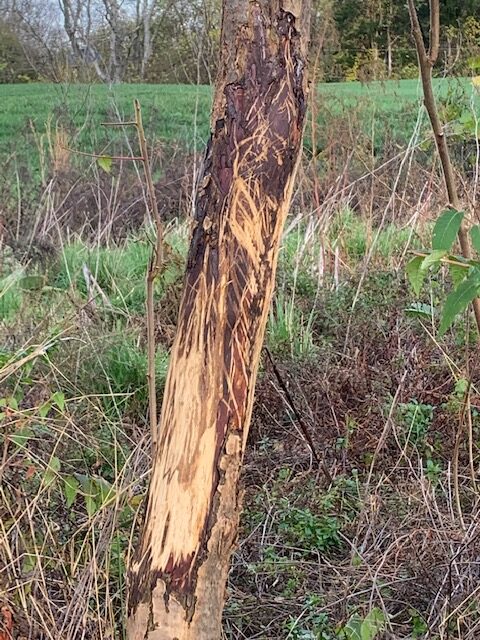
Deer damage can be costly, unsightly, and even deadly. In some cases this damage can have long term effects and disfigure your landscape. Annually, deer damage exceeds $2 billion nationwide. If that wasn’t bad enough, deer also bring deadly disease carrying travelers into your yard, threatening the safety of your loved ones.
One way bucks can fatally damage trees is by scraping their antlers on the bark. They do this to remove their antler velvet in the early fall and into winter. Rubbing trees to attract females during the mating season and marking their territory often results in torn tree bark and broken branches.
Deer browsing: Damage to trees and shrubs can be extensive, affecting plant shape and exposing bare wood to disease and insects.
Mating “rut”: From early September through November male deer are looking to clean their antlers of summer velvet, while at the same time marking territory during the breeding season. In addition to rubbing antlers against trees to remove velvet, buck deer assert themselves by thrashing and battering the tree for noise effect.
Tree Damage: Tree damage involves shredding of bark from a foot or so above the ground, to three to four feet up, exposing underlying wood. If rubbed all the way around, the trunk can be effectively girdled.
If small trees are bent over by the deer, main leaders and smaller limbs can be broken off. Usually the damage is done over a 24 hour period. Because this is also a territorial action, the buck may revisit trees they like in subsequent years.
> Read here to learn more about deer damage and how to fix damage that has already been done.
What are the safety issues related to deer?
Accidents: Over population of deer in neighborhoods can also cause car damage and accidents when they run out into the streets.
Attacks: Always keep in mind a buck in rut is an unpredictable animal. It has an agitated and angry appearance, and will often stand its ground and not be afraid. With its sharp antlers it is a clear danger, and challenging it or attempting to scare it away may result in an attack.
Ticks: When deer enter your yard they bring ticks that can endanger your family. These ticks often carry Lyme diseases, Babesiosis, or other diseases that can lead to great illness or even death.
How to Protect Trees From Deer
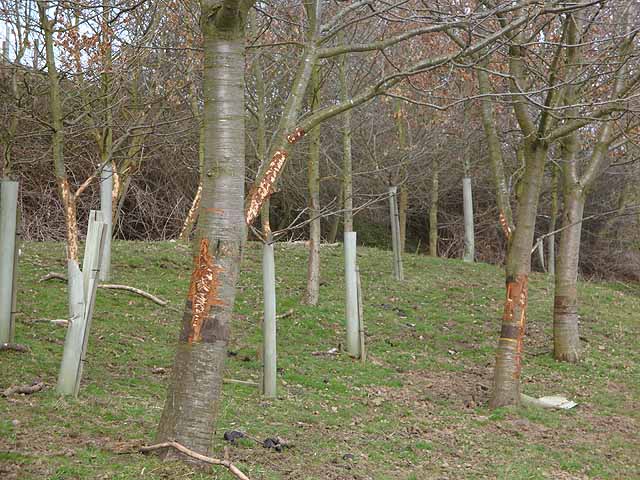
There are various ways you can protect trees from deer activity, with various levels of effectiveness. There are DIY tricks like keeping the bucks away from your trees using fencing and other barriers. You can also consider sprays and other deterrents listed below. (A great bonus is that they also work at protecting trees from deer and rabbits.) Best protection of all, however, is our Deer Deterrent & Management Program (more on this later).
Q: What Can I Spray on My Trees to Keep Deer Away?
Sprays aren’t usually as effective as physical barriers are for problems like deer rub. But if you’re determined to avoid any type of fencing, etc. you can try the many brands of deer repellant spray or make your own using eggs, garlic, and chili peppers.
Q: Do Coffee Grounds Keep Deer Away?
There are quite a few opinions on what will keep deer away besides physical barriers. Some of these smelly deterrents include:
- Strongly-scented soaps
- Coffee grounds (wet and let sit in bag 7-10 days for maximum effect)
- Garlic
- Mothballs
- Decaying fishheads
- Processed sewage
- Hair
- Blood meal
- Fabric Softener
These may work for a little while, but they’ll lose their repelling power after irrigation or rainfall. Another reason they stop working is that deer will quickly get acclimated to those smells. They get used to these smells because return to the same places often.
Interested in our Deer Deterrent & Management Program?
Which Shrub & Tree Species Do Deer Like To Eat?
In the Northern Virginia, DC Metro area, the #1 plant food that deer like most are Euonymus shrubs. Our arborists estimate that in our area, 1 out of every 3 homes has some type of Euonymus in their yards.
Although not as “tasty,” the food deer in our area also like going after are:
- Hosta (Host sp.)
- Candy Lily (Pardancanda x norrisii)
- Roses
- Yews (Taxus sp.)
- American Arborviate (Thuja occidentalis)
- Evergreen Azaleas & Rhododendron (Rhododendron sp).
Read here to learn more about the plants that attract deer and what plants deer hate.
How Do I Keep Deer From Eating My Trees?
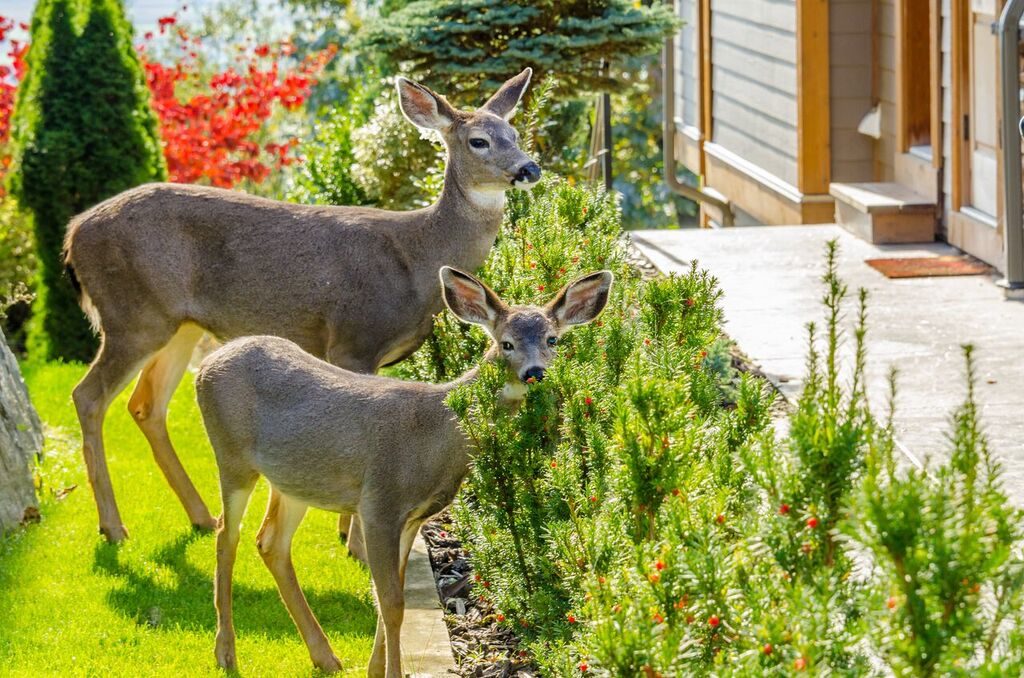
One of the best ways to keep deer away from trees and shrubs is to install physical barriers. Let’s take a look at the options. Pick one that you wouldn’t mind looking at every day.
1. Nylon Netting
Drape nylon netting (mesh screen) over shrubs that grow lower to the ground. Secure them by pinning the corners down. Use zip-ties or twine attached to tent stakes.
2. Does Burlap Protect Trees From Deer?
Burlap sacks are inexpensive yet very strong. They can protect young shrubs from hungry dear during the wintertime. Burlap will protect your foliage from being eaten and protect the branches from bending during a heavy snowfall.
3. Wire Cages
You’ll want deer cages for trees to be at least 6 feet tall. Place them about 3 feet out and then stake them down. Even though deer can easily jump over a 6-foot obstacle, they very rarely enter small spaces.
4. Tree Wrap
Tree wrap comes in plastic or paper and will protect your thin-barked or young trees from bucks. Do you know how long to protect trees from deer? The answer is, all year round.
Replace this wrap every 3 months or so, as insects may infest or moisture could build up. These problems would defeat the purpose altogether, so mark it on your calendar.
5. Deer-Proof Fences
For this, we suggest surrounding your entire yard in any type of 8-foot fencing. Types that work include:
- Residential fencing
- Exclusion fencing
- Binder twine fencing
- Snow fencing
Deer will attempt to get under your fence so make sure there’s no gap at the bottom. In addition, remember to allow for slack so you have some to pin to the ground with stakes. This works great with polypropylene mesh fencing.
Deer will find a broken area or whole and try to rip through it, so buy a quality fence and deer-proof the gate. Check your fence often for any needed repairs so you can avoid breaches. Metal fences should be galvanized and polypropylene fences should be UV-protected.
6. Tree Guards
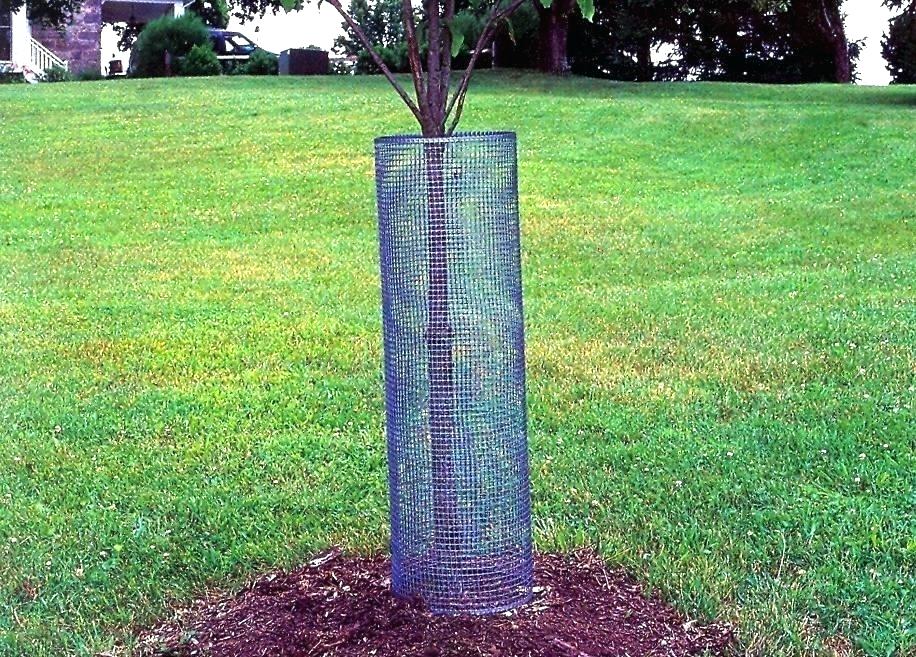
Tree guards are usually made of a plastic netting mesh. Some are constructed of a vinyl spiral so they can wrap around the trunk while allowing for natural growth. These work on small and large trees alike and are easily cut to size.
But you may kick yourself when you realize that something as cheap and simple as chicken wire can protect your trees from deer. Cut it to size, bend into a cylindrical shape around your tree or shrub, and push into the ground a few inches to secure.
Consider plastic tree guards as well, which you can purchase online or in gardening stores. They protect your tree from sunscald and make it impossible for deer to reach the bark. That is, unless, they bribe a bobcat into doing their dirty work (doubtful).
Other guards that act as tree protectors from deer include plastic tubes or pipes. These are best for smaller diameter trees and can be fitted. Choose a light color to avoid overheating your tree.
More Ways to Protect Trees From Deer
You’d be surprised at what will attract deer besides trees and shrubs. They’ll enter your yard for pet food dishes and/or bird feeders. They are also attracted to yew, cedar, maples, rhododendron, and roses, and more, so spray those plants with deer repellant.
In addition to your physical barrier, choose plants that dear aren’t fond of, such as those with spines, strong odors, fuzzy leaves, or fern-like foliage. Install sprinklers that run on motion detectors to scare deer away as you watch and laugh.
The #1 Way To Protect Trees From Deer
While the above DIYs might be useful, each one comes with a limit to its effectiveness.
To help you and your trees stay safe and protected from deer, our team of Certified Arborists and tree service experts have put together a longer-lasting deer deterrent solution. In comparison to the other DIY solutions, our deer deterrent will protect your trees, shrubs, and family from the various deer damage and safety issues.
Our Deer Deterrent & Management Program applied by a tree service expert, will:
- Deter the deer from your property.
- Protect plants from browsing deer.
- Protect your family from ticks transmitted by deer.
- Save you hundreds or thousands of dollars on spring landscaping aimed at repairing deer damage.
Darn Deer!
Now you have your questions answered, such as: How do I keep deer from eating my trees? What can I spray on my trees to keep deer away? Do coffee grounds keep deer away? Does burlap protect trees from deer?
Don’t let deer ruin your trees and garden. Keep your plants protected by mixing and matching methods, or, for the best tree protection of all, meet with one of our Certified Arborists to discuss our Deer Deterrent & Management Program: book an appointment online today, or call us at 703-573-3029!


